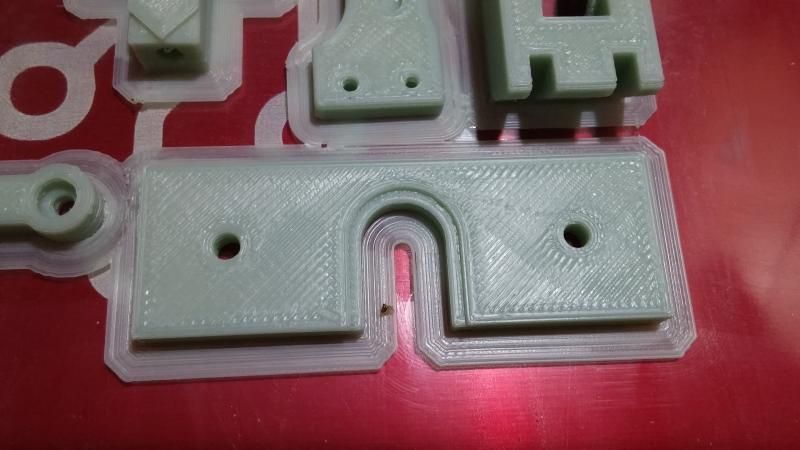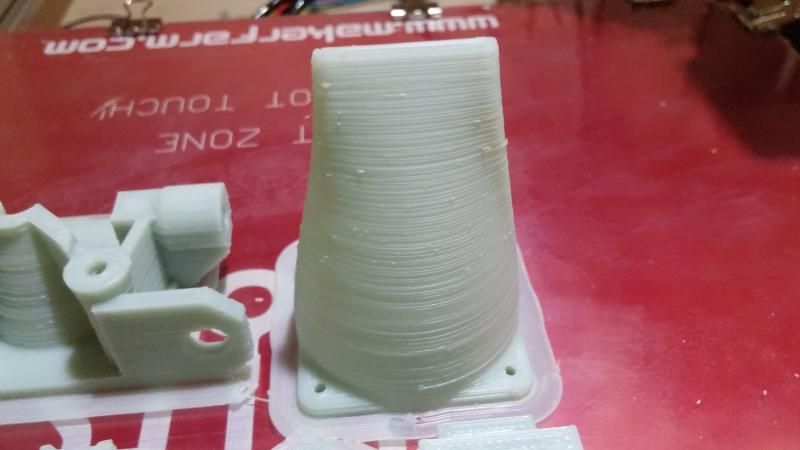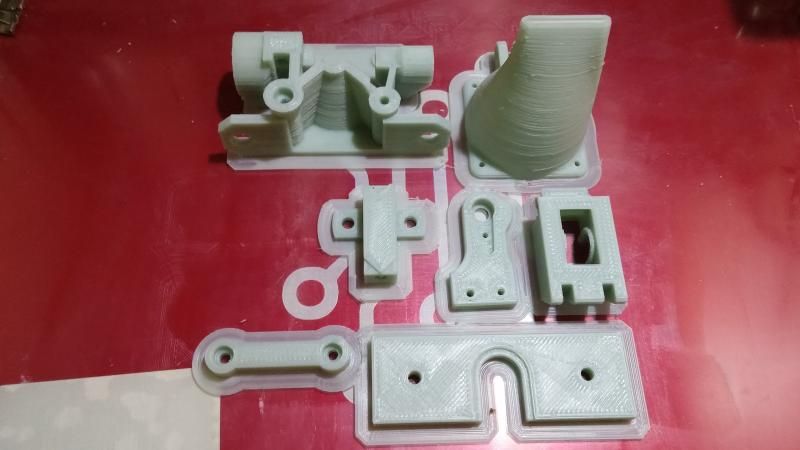Results 11 to 20 of 166
Thread: New 12" user and I am LOST!
-
02-05-2015, 10:53 AM #11
Information on preventing issues with the unused maximum position endstop switches:
In the configuration.h file, look for the DISABLE_MAX_ENDSTOPS definition. You want the line to look like the following, without any // preface:
#define DISABLE_MAX_ENDSTOPS
-
02-05-2015, 11:45 AM #12Engineer-in-Training

- Join Date
- Feb 2015
- Posts
- 371
Could you explain what this is exactly doing to the printer? Max endstops, seem to me like they would be the limits as the z travels up? Are there endstops in both directions? I thought the switches controlled the max travel. I can give it a shot but this seems like it may open doors for more troubles and over driving the system potentially.
-
02-05-2015, 11:55 AM #13Engineer

- Join Date
- Nov 2014
- Posts
- 522
max endstops aren't used, we use min endstops and software to limit the max travel. so the max endstops should app be disabled
edit: resources i have found to ensure you have the proper version of python and pyserial installed. It is the sourcecode page for pronterface, it is about midway down the page.
https://github.com/kliment/PrintrunLast edited by sniffle; 02-05-2015 at 12:03 PM.
-
02-05-2015, 02:23 PM #14
The issue is if the max endstops are enabled in the firmware but not present in the hardware. I'm not sure that would explain any of your issues - but it is an easy thing to rule out.
Having max endstops enabled but not in the hardware has messed up the reliability of the ABL process for some people. Another user just in the last couple of weeks had homing problems that were attributed to the max endstop issue. Homing consists of 3 movements: first move the axis until the endstop closes, doing so at high speed. Then back away from that position. Finally, reverse and move again until the endstop closes, but at a reduced speed likely in an attempt to be more precise at the axis final position. In his case, homing would often just do the first movement and quit. What we determined is that Marlin couldn't do the 2nd part that backed away from home since the hardware was falsely indicating it was already at the max endstop position. Configuring Marlin to disable the max endstops solved his homing problems.
So, I'd just start by making sure any issue with max endstops possibly being enabled in the firmware has been eliminated.
Then after commanding the printer to home (from LCD vs Pronterface shouldn't matter), adjust bed leveling to the thickness of a piece of paper (0.1mm) between the nozzle and the glass. Many recommend doing this with the nozzle and bed set to the temperatures you'll print with. If you think the homing process leads to the nozzle being pressed into the glass, readjust the Z endstop and repeat the homing before doing the bed leveling. Repeat the homing and bed leveling a few times or as required, using either the LCD (only 0.1mm travel steps are allowed for Z), pronterface, or manually turning the Z-rods to raise Z a bit before each pass. You're done with the endstop adjustment and the bed leveling when the nozzle gap remains consistent from pass to pass.
I suggest not attempting to set a Z offset into the slicer to compensate for the nozzle gap, at least not initially. If the homing process properly sets Z to the paper gap above the glass but your print starts with the nozzle raised 1-2mm, something must be telling the printer to raise the nozzle up. Make sure the slicer isn't set for something inadvertent like start printing at layer nn or height zz.
To confirm what your slicer is outputting, you can load your gcode file into a gcode viewer like gcode.ws (that's the URL for it). Look at the layer by layer detail to see what the viewer says your print height is. If the viewer shows the print starting at 1 or 2mm height, something is wrong in the slicer. Feel free to post the gcode file for someone to provide an independent look at it.
On at least the 20x4 character LCD displays, the LCD can also be helpful in that it shows the current Z height. If the print does start at that 1 or 2mm gap above the bed, what is the printer LCD showing when this happens? If it is showing 1 or 2mm, something is likely telling the printer to do that. If it shows some fraction of a mm while the nozzle is actually way high, we have more work to do to figure out what is going on.
For at least initial prints, only focus on what is happening with the skirt and the first few layers. The skirt should be applied evenly around the part. If it isn't, there's no reason to continue the print. If this happens after the bed was verified to be level, something is mechanically drifting. Are the eccentric spacers all adjusted so there's no play in either the Y bed or the X carriage?
Abort the print after a few layers and let the print cool so that you can remove it and look at the bottom surface of the print. The first layer is critical - if it isn't laid right, the rest of the print can and likely will suffer. The first layer needs to be printed so that the extrusion is squished onto the glass. If you see any substantial gap between the extrusion lines on the first layer, the first layer isn't being printed properly. Once the first layer is printing properly, then you can let the print complete and see how the rest of it goes.
A few additional points - MakerFarm ships the printer kits with some plastic tubing to use as the connection between the Z motors and the threaded Z rods. Some people have ran into issues with these connections slipping. As a minimum, it would be a good idea to add some zip ties around the tubing with the ties pulled as tight as you can get them. Finally, it would be a good idea to check/calibrate your extruder before scrutinizing your print results. I can't speak to the firmware you have, but the MakerFarm firmware builds at least used to lead to extrusion that was on the light side.Last edited by printbus; 02-05-2015 at 02:30 PM.
-
02-05-2015, 03:44 PM #15Engineer-in-Training

- Join Date
- Feb 2015
- Posts
- 371
Some more pics...
This is a pic of the part I printed using an afinia we have at school. No tuning required. I think the slicer they use is proprietary and does a better job, that is just my unexperienced observation.
On the left in this is the part printed with slic3r. The knob next to it is the exact knob as above printed on the maker. Both in ABS and .4mm nozzle
-
02-05-2015, 04:06 PM #16Engineer

- Join Date
- Nov 2014
- Posts
- 522
just comparing the two pictures your printer is printing a lot hotter than your school one. not that fine tunning via pictures is the point right now, but dull prints mean a cooler extrude, shiny means a hotter extrude
-
02-05-2015, 04:08 PM #17Engineer-in-Training

- Join Date
- Feb 2015
- Posts
- 371
So I went to this page, wow. That is a lot of Greek to me! I went to the page and navigated about half way to find this...
Mac OS X Lion- Ensure that the active Python is the system version. (brew uninstall python or other appropriate incantations)
- Download an install [wxPython2.8-osx-unicode] matching to your python version (most likely 2.7 on Lion, check with: python --version) from: http://wxpython.org/download.php#stable Known to work PythonWX: http://superb-sea2.dl.sourceforge.ne...rsal-py2.7.dmg
- Download and unpack pyserial from http://pypi.python.org/packages/sour...ial-2.5.tar.gz
- In a terminal, change to the folder you unzipped to, then type in: sudo python setup.py install
- Repeat 4. with http://http://pyglet.googlecode.com/...glet-1.1.4.zip
The tools will probably run just fine in 64bit on Lion, you don't need to mess with any of the 32bit settings. In case they don't, try
- export VERSIONER_PYTHON_PREFER_32_BIT=yes in a terminal before running Pronterface
Not sure what to do with this as I don't know how to use terminal.
-
02-05-2015, 04:11 PM #18Engineer-in-Training

- Join Date
- Feb 2015
- Posts
- 371
In the top pic of the knob (Afinia) I like how the surface is nice and uniform. The bottom pic (maker) is all snaggy and ugly. You can even see where it looks like the nozzle scrapped across the print it looks like. Are the retractions not setup right?
I am just using the config that Colin posted.
-
02-05-2015, 04:21 PM #19Engineer

- Join Date
- Nov 2014
- Posts
- 522
I just finished printing these... It's very possible to get it to work and well be patient we'll get you there :-) just keep an open mind to learning



-
02-05-2015, 04:33 PM #20Engineer-in-Training

- Join Date
- Feb 2015
- Posts
- 371
Those are amazing! In one of the last emails from Colin, he stated that the nozzle will be below the glass level in some cases to get a good first layer print. I just can't accept that as true. There exists the possibility for damage in my mind.
What problem should I tackle first as I feel like I am running in too many directions first.
Pronterface?
Z-Axis?
Filament calibration?





 Reply With Quote
Reply With Quote





Ender 3v2 poor printing quality
10-28-2024, 09:08 AM in Tips, Tricks and Tech Help